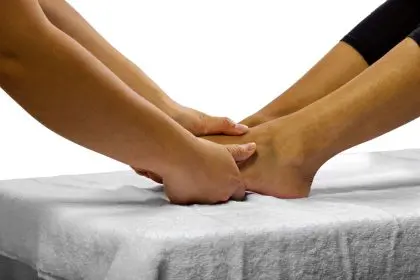The human head weighs approximately 10-12 pounds when properly aligned over the spine. But as it tilts forward, the position most office workers adopt while focusing on screens, that weight effectively increases. At just 15 degrees of forward head posture, the load on the cervical spine nearly doubles to 27 pounds. At 45 degrees, a common texting angle, it surges to 49 pounds.
This mechanical reality explains why an estimated 65% of office workers experience neck pain annually, with many developing chronic discomfort that extends beyond work hours. The neck muscles weren’t designed to sustain this type of prolonged loading, yet modern work demands create precisely these conditions day after day.
While ergonomic improvements help address the underlying causes, regular movement remains essential for relieving accumulated tension and preventing long-term problems. The good news: even brief stretching sessions can provide significant relief when performed consistently throughout the workday.
Understanding desk-related neck tension
The primary muscles affected by prolonged desk work include the upper trapezius, levator scapulae, suboccipitals, and sternocleidomastoids. These muscles become chronically shortened and tense from maintaining forward head posture while simultaneously weakening their antagonist muscles that should help maintain proper alignment.
This imbalance typically manifests as tightness across the tops of the shoulders, pain at the base of the skull, difficulty turning the head fully, and a sensation of constant fatigue in the neck region. Left unaddressed, these issues can progress to headaches, jaw tension, and even nerve impingement symptoms like tingling in the arms or hands.
Most concerning is how quickly these patterns become established. Research indicates that myofascial changes begin after just 20 minutes of poor positioning, with the body gradually adapting to these suboptimal postures over time. This adaptation makes returning to proper alignment increasingly difficult without consistent countermeasures.
These five targeted stretches address the most common patterns of desk-related neck tension. For optimal benefit, perform them as a complete sequence several times throughout the workday rather than waiting until discomfort becomes severe.
Upper trapezius release with breath synchronization
The upper trapezius muscles, which run from your neck to your shoulders, often bear the brunt of postural stress. This stretch specifically targets these overworked fibers while incorporating breathing to enhance relaxation.
How to perform:
- Sit tall with your right hand gently holding the underside of your chair or seat
- Place your left hand on the right side of your head, above your ear
- Gently tilt your left ear toward your left shoulder without lifting your shoulder
- For deeper release, look down toward your left armpit
- Inhale deeply, then exhale slowly while increasing the stretch slightly
- Hold for 20-30 seconds while taking 3-4 complete breaths
- Repeat on the opposite side
This position creates a safe, controlled stretch through the side of the neck and upper shoulder. The hand placement prevents compensatory shoulder lifting, a common mistake that reduces the stretch’s effectiveness.
The breath component activates the parasympathetic nervous system, helping chronically tight muscles receive the signal to release. For particularly stubborn tension, hold for up to 60 seconds per side, focusing on relaxing more deeply with each exhalation.
Levator scapulae lengthening with rotation
The levator scapulae muscles connect your upper shoulder blades to your neck and often develop trigger points that refer pain up into the base of the skull. This stretch targets these specific fibers through their full range.
How to perform:
- Sit tall with your right hand holding the underside of your chair
- Place your left hand on the back of your head
- Turn your nose toward your left armpit
- Gently guide your head forward and slightly down
- Feel for the stretch in the right side of your neck into the shoulder blade
- Hold for 15-20 seconds while taking deep breaths
- Repeat on the opposite side
The key to this stretch’s effectiveness lies in the precise angle. The rotation component (turning toward the armpit) specifically targets the levator muscle fibers in a way that simple side bending cannot achieve.
For enhanced results, perform this stretch after applying gentle pressure with your fingers to any tender points found along the upper inner border of your shoulder blade. This self-massage helps prepare the muscle for more effective stretching.
Suboccipital release with chin tucks
The suboccipital muscles, small but crucial muscles at the base of your skull, often become chronically shortened from forward head posture. This exercise both stretches these muscles and reinforces proper head alignment.
How to perform:
- Sit tall with your spine in natural alignment
- Place two fingers on your chin without applying pressure
- Gently guide your chin straight back, creating a “double chin”
- Hold the retracted position for 2-3 seconds
- Slowly release to neutral position
- Perform 10 repetitions
- For deeper release, hold the retracted position while nodding your head slowly up and down 5 times
This movement may feel subtle but addresses a critical postural component. The suboccipital muscles directly influence the rest of the neck’s alignment, when they’re chronically shortened, they pull the head into forward posture, creating a cascade of compensations down the spine.
The nodding variation adds gentle movement through these typically restricted joints at the top of the neck, improving both mobility and proprioception (your sense of where your head is in space), key for maintaining better posture when returning to work.
Pectoral stretch with thoracic extension
While not directly neck muscles, tight chest muscles contribute significantly to rounded shoulders and forward head posture. This stretch addresses this common pattern while promoting upper back mobility.
How to perform:
- Stand in a doorway with your forearms placed against the door frame
- Position your elbows at approximately shoulder height
- Step one foot forward through the doorway
- Gently lean forward until you feel a stretch across your chest
- While holding this position, slightly arch your upper back
- Hold for 20-30 seconds while taking deep breaths
- For variation, adjust arm height to target different portions of the chest muscles
This stretch works by addressing a key underlying contributor to neck tension that many targeted neck stretches miss. The rounded shoulder position created by tight chest muscles forces the neck into compensation patterns that no amount of direct neck stretching can fully resolve.
The thoracic extension component (arching the upper back) further enhances the stretch’s effectiveness by improving mobility in the upper spine, a region that typically becomes rigid with prolonged desk work. This combined approach addresses both the symptoms and contributing factors simultaneously.
Neural glides for tension relief
When neck tension persists despite stretching, nerve irritation may be contributing to the problem. Neural gliding techniques help reduce irritation in the nerve pathways that can contribute to persistent neck and arm discomfort.
How to perform:
- Sit tall with your right arm extended to the side at shoulder height
- Slowly turn your head away from the extended arm (looking left)
- Gently tilt your head toward the opposite shoulder
- While maintaining this position, slowly bend your wrist backward, then forward
- Perform 5-10 gentle repetitions of the wrist movement
- Repeat on the opposite side
This technique creates gentle movement in the nerve pathways that run from the neck down the arm. Unlike static stretches, the controlled movement helps reduce nerve adhesions and irritation that often accompany chronic muscle tension.
The key to effective neural gliding lies in keeping the movement gentle and pain-free. If you feel tingling or electrical sensations, reduce the range of motion until you can perform the exercise comfortably. Consistency with this technique often resolves persistent symptoms that stretching alone cannot address.
Implementing an effective relief routine
For maximum benefit, these stretches should be incorporated throughout the workday rather than saved for when pain becomes severe. A proactive approach prevents tension from accumulating to the point where more intensive intervention becomes necessary.
Frequency recommendations
Perform the complete sequence at least three times daily:
- Mid-morning (approximately 2 hours into work)
- After lunch
- Mid-afternoon (approximately 2 hours before ending work)
For particularly intensive computer sessions, set a timer to briefly stretch every 45-60 minutes. Even performing just one or two of these movements during short breaks provides significant preventive benefits.
Environmental reminders
Because prevention requires consistency, creating environmental triggers helps establish the habit. Effective approaches include:
- Setting calendar reminders that coincide with natural work transitions
- Placing small visual cues at your workstation (like a colored dot on your monitor)
- Pairing stretching with existing habits like finishing a task or refilling water
- Using smartphone apps specifically designed for stretch reminders
These environmental cues bypass the need for willpower or remembering, making consistent implementation much more likely.
Complementary approaches
While these targeted stretches provide immediate relief, combining them with these complementary approaches creates more comprehensive protection against desk-related neck issues.
Movement variety
Beyond scheduled stretching, simply changing positions frequently throughout the day reduces sustained loading on neck structures. Standing periodically, walking while taking calls, or alternating between different working positions all contribute to reduced tension accumulation.
Micro-exercise
Brief strengthening exercises for the deep neck flexors and lower trapezius muscles help correct the underlying imbalances that contribute to poor posture. Even 1-2 minutes of targeted activation exercises several times weekly can significantly improve postural endurance.
Mindful body awareness
Developing increased sensitivity to early warning signs of tension allows for earlier intervention. Periodic body scans, taking 30 seconds to mentally check in with different body regions, help identify tension patterns before they become problematic.
Hydration and warmth
Maintaining adequate hydration supports proper muscle function, while applying gentle heat to persistently tight areas increases blood flow and tissue extensibility. A warm compress applied for 5-10 minutes before stretching enhances the effectiveness of the movements.
When to seek additional help
While these approaches successfully address most desk-related neck tension, certain symptoms warrant professional assessment. Consider consulting a healthcare provider if you experience:
- Pain radiating beyond the neck and shoulders into the arms
- Numbness or tingling in the hands or fingers
- Persistent headaches that don’t respond to self-care
- Difficulty turning your head that doesn’t improve with stretching
- Pain that wakes you from sleep or continues to worsen despite intervention
These symptoms may indicate underlying issues requiring specific treatment beyond self-management strategies.
For most desk workers, however, consistent implementation of these targeted stretches provides both immediate relief and long-term protection against the modern epidemic of tech neck, allowing for productivity without the pain that too often accompanies it.















